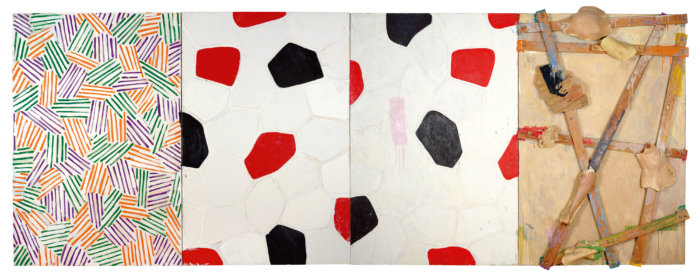Going beyond the familiars of his encaustic-rendered pre-Pop Art flags, maps, targets, numbers and letters, allowing viewers into his genre-jumping scope and influence: this is the raison d’etre behind “Jasper Johns: Mind/Mirror” — the most comprehensive retrospective of the quintessentially American painter-printer-sculptor’s work opening simultaneously at New York’s Whitney Museum of American Art and the Philadelphia Museum of Art on Sept. 29.
With nearly 500 pieces linked by loose thematic elements, viewers in both cities can thrill to Johns’ oft-repeated memes and multiple arcs and inspirations across his 91 years. There are iconic totems of the early 1950s such as American flag paintings and Duchamp-inspired bronze sculptures of lightbulbs, to items marking time spent in Japan and visits to Philadelphia, to a ruminatively dark period in the 80s as he embraces the eternal and wrestles with death of friends and fellow artists felled by AIDS.
Along with previously unseen paintings and drawings—his grinning skeletons are particularly winning—recent and new works completed within the last year are a delight and highlight of the sign-and-symbol-heavy “Mind/Mirror,” as is the chance to consider Johns’ epoch in the present day. For instance, what do Johns’ flags represent at a time when our flag’s image divides us along racial, political and social lines?
“Jasper changed the landscape of American art in 1954 when he made Flag,” says Sarah Vogelman, the PMoA’s Exhibition Assistant for this retrospective, regarding Johns’ launching of Pop Art, Conceptualism, and Minimalism. “Johns is responsible for the shock waves that went through the art world at that time. And he has continued to evolve.”
Vogelman and I discuss the “intimate connection” of Johns to Duchamp, and how the latter’s longtime permanent collection at the Philadelphia Museum of Art led to a friendship between the Dada elder and the young painter after Johns and Robert Rauschenberg visited the Philly Duchamp exhibition in 1958. “Mind/Mirror’ helps portray their narrative thread and how Johns was an inheritor of Duchamp’s legacy,” states Vogelman, pointing toward Jasper’s 1960 bronze and glass Flashlight for proof.
Originally intended to debut during Johns’ 90th birthday in 2020 (slowed by COVID’s restrictions), “Mind/Mirror’s” multi-room setting just happens to coincide with the Philadelphia Museum of Art’s new look and expansion. With that, the autonomous, yet unified twin exhibitions at Philadelphia’s Museum of Art and the Whitney is defined by its context in relation to each academy’s definition.
“While the Whitney is focused strictly on American art, we are an encyclopedic institution from the past to the present day, globally, and, for this exhibition, we have a gallery focused on Johns’ relationship to Japan.”

These rarely-viewed paintings and drawings in the Johns/Japan gallery has a biographical portion surveying the painter’s earliest relationship with Japan during his time in the Army, as well as his return (a three-month residency through the Minami Gallery) once his stardom was established in 1964. Along with personal lent from Johns’ own collection from his time in Japan are a handful of paintings and objets from Japanese artists and friends whose work also glean influence from Duchamp. Another part of the Johns’ Japanese gallery revolves around his latter-day recollections of his time there, “from a geographical distance,” entitled Usuyuki, which includes a handful of prints and drawings not viewed in the United States since 1983.
Another singular space within the Johns’ exhibition revolved around trial and working proofs rarely seen by the public as they’re not often looked upon as part of the artist’s work.
“For Johns, however, that was very much not the case as he saved, and signed them,” notes Voglelman. “His archiving these proofs show how important they actually are, and that they too are important works of art as well. He was working through these prints – that was a big deal for us in this show as it was deigned to show the mind of Johns and his own working logic.”
It is a gallery of paintings and prints done up in darker purple hues with thought bubbling designs and blotchy phantom limbs dedicated to Johns’ 1980s that is most stirring. This includes work such as 1982’s Perilous Night, a painting with sculptural elements that creates a mournful vibe from the moment we lay eyes upon it. Stemming from Johns’ own forlorn feeling from the decline of artists friends throughout the AIDS epidemic, as well as the 1982 death of avant-garde theorist and composer John Cage, the work is both eerily reminiscent of Johns’ ready-made past with his mannequin-like sculptural element, yet emboldened by deep emotions rarely viewed in the painter’s work prior to this. The evolution of Johns, though hardly complete in 1982 (as he still – in 2021 – continues to create) has found a way into new dialogues based on the artist’s own famed tropes. Few artists could move so nimbly through the decades, utilizing and surpassing their own language, as does Jasper Johns.
“Our hope is that people will walk away from ‘Mind/Mirror’ with the idea of a Johns they didn’t know before,” says Vogelman. “An icon who is vulnerable and sensitive, and incredibly diverse.”





























